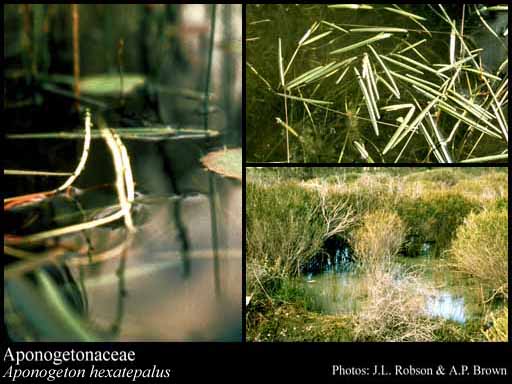- Reference
- Bot.Mag. Tab.4894 (1856)
- Name Status
- Current







Scientific Description
Common name. Cape-pondweed Family.
Habit and leaf form. Herbs; laticiferous. Perennial; cormous, or rhizomatous. Hydrophytic; rooted. Leaves emergent and floating. Often heterophyllous. Leaves alternate; petiolate; sheathing. Leaf sheaths with free margins. Leaves simple. Leaf blades parallel-veined; cross-venulate (the tissue between the veins breaks up as the leaf matures, leaving a network with holes). Axillary scales present. Stem anatomy. Secondary thickening absent.
Reproductive type, pollination. Fertile flowers hermaphrodite. Unisexual flowers absent. Plants hermaphrodite. Floral nectaries present. Nectar secretion from the gynoecium (from the sides of the carpels). Entomophilous; via beetles, or via hymenoptera.
Inflorescence and flower features. Flowers aggregated in ‘inflorescences’ (commonly projected above the water in 1–3 spikes). Inflorescences pseudanthial (sometimes), or not pseudanthial; spatheate (the spathe caducous). Flowers small; usually very irregular; when irregular (i.e. usually), zygomorphic. The floral asymmetry involving the perianth. Flowers cyclic, or partially acyclic. Sometimes the gynoecium acyclic. Perigone tube absent. Perianth of ‘tepals’, or absent; when present, (1–)2(–6); 1 -whorled; free; petaloid; when present, white (usually), or blue, or purple. Androecium 6 (usually 3 + 3), or 25–100 (i.e. sometimes ‘many’). Androecial members branched (when ‘many’), or unbranched; 2–4 -whorled. Stamens 6(–50); diplostemonous to polystemonous. Anthers dehiscing via longitudinal slits; extrorse, or latrorse; tetrasporangiate. Gynoecium (2–)3–6(–9) carpelled. Carpels isomerous with the perianth, or reduced in number relative to the perianth, or increased in number relative to the perianth. Gynoecium apocarpous; eu-apocarpous to semicarpous (basally fused to varying extents); superior. Carpel apically stigmatic; 1–8 ovuled. Placentation basal. The ‘odd’ carpel anterior. Stigmas dry type; papillate; Group II type. Ovules ascending; anatropous.
Fruit and seed features. Fruit non-fleshy; more or less an aggregate. The fruiting carpel dehiscent; a follicle. Seeds non-endospermic; with starch. Cotyledons 1. Embryo chlorophyllous; straight. Seedling. Hypocotyl internode present. Mesocotyl absent. Seedling collar not conspicuous. Cotyledon hyperphyll elongated; assimilatory; dorsiventrally flattened. Coleoptile absent. Seedling non-macropodous. Seedling cataphylls absent. First leaf dorsiventral. Primary root ephemeral.
Geography, cytology, number of species. World distribution: palaeotropical and South Africa. X = 8. 47 species.
Economic uses, etc. Some aquarium and watergarden ornamentals.